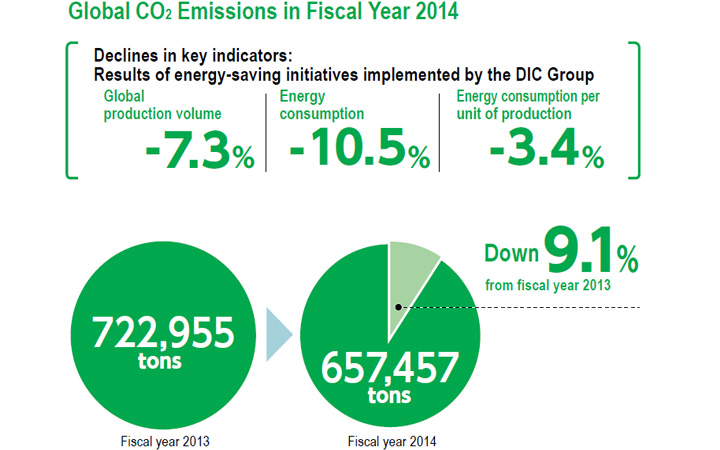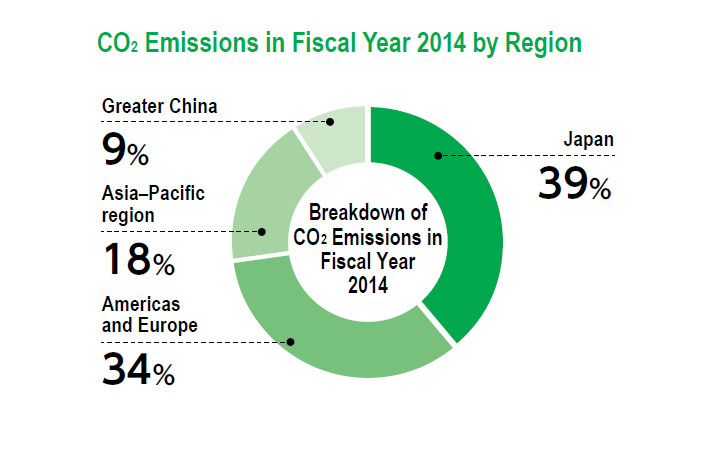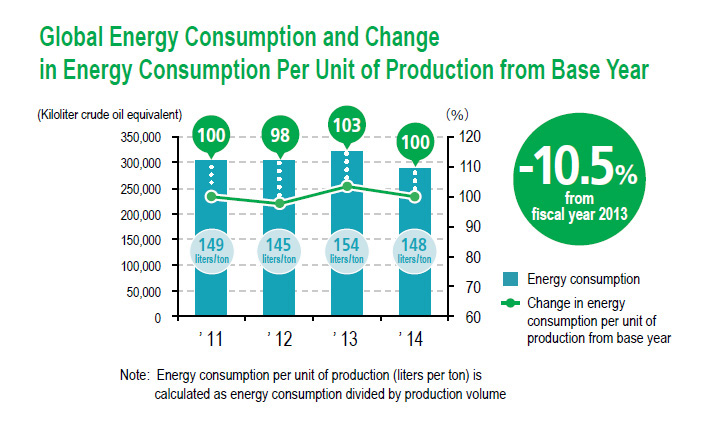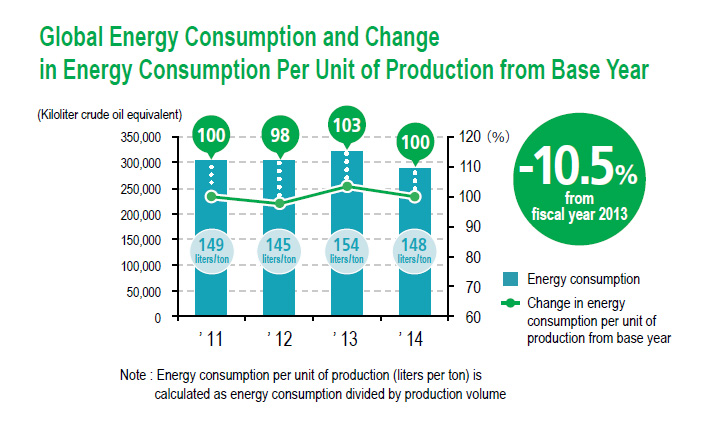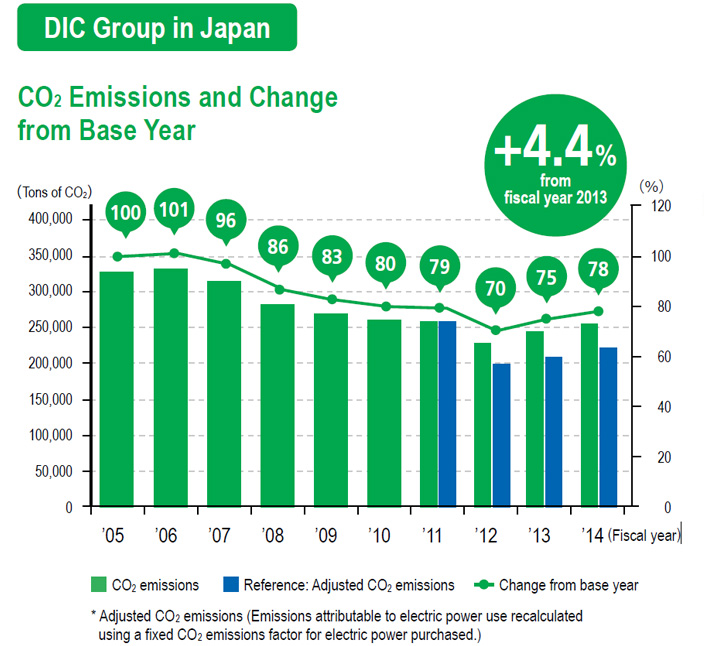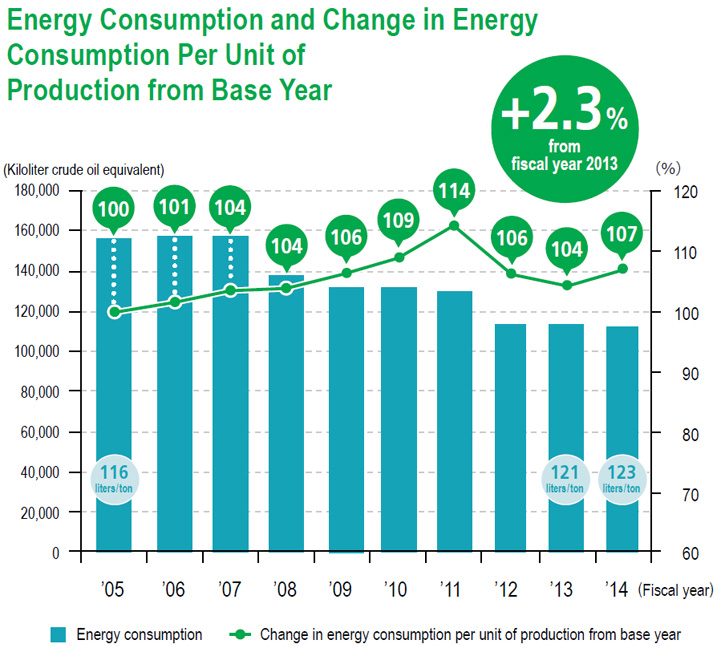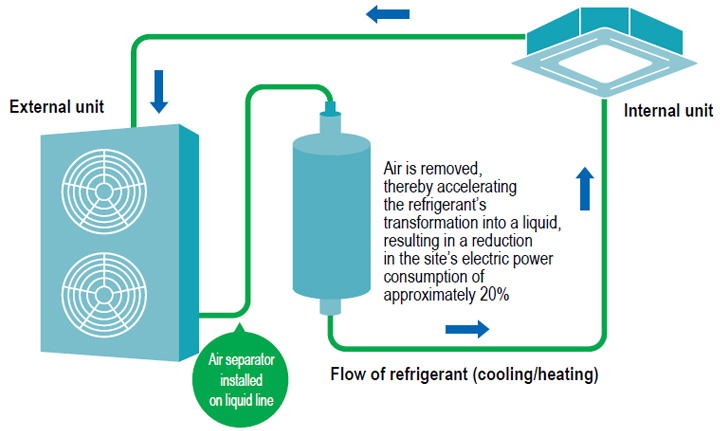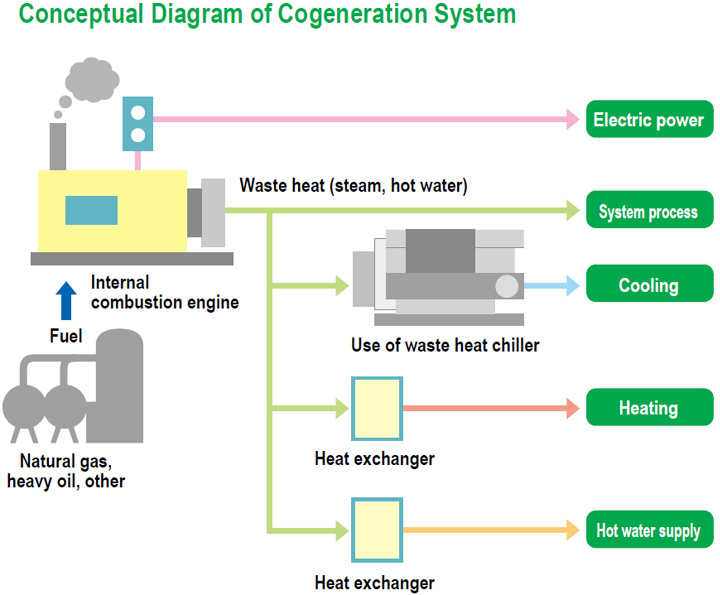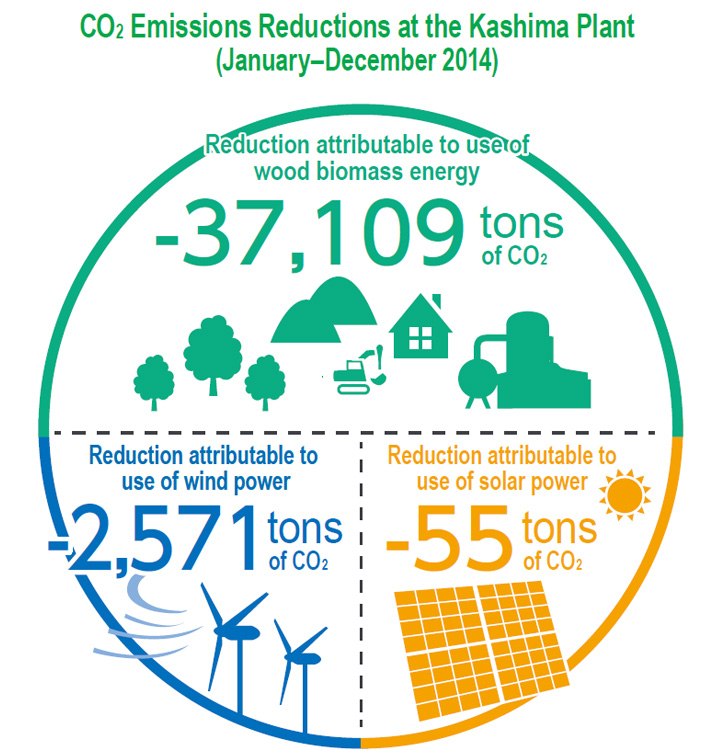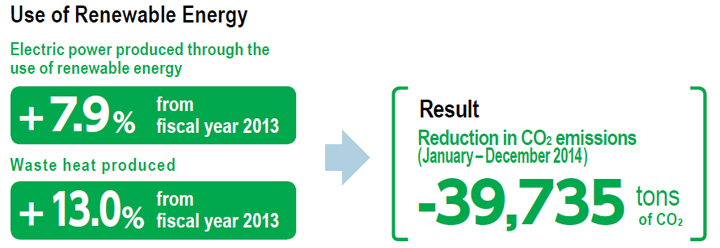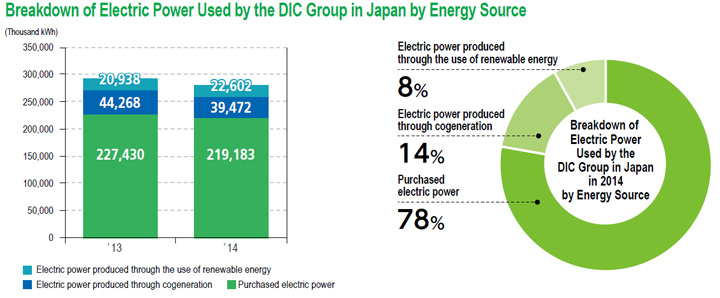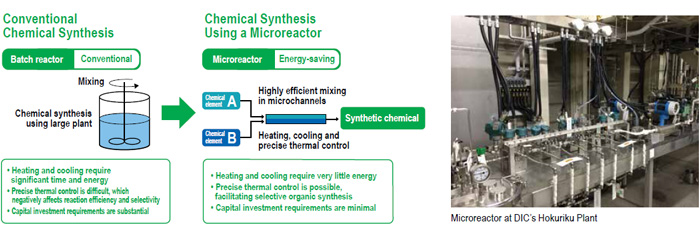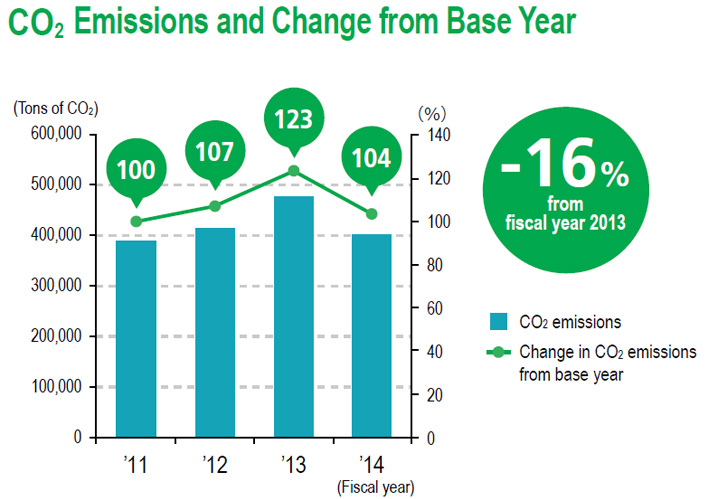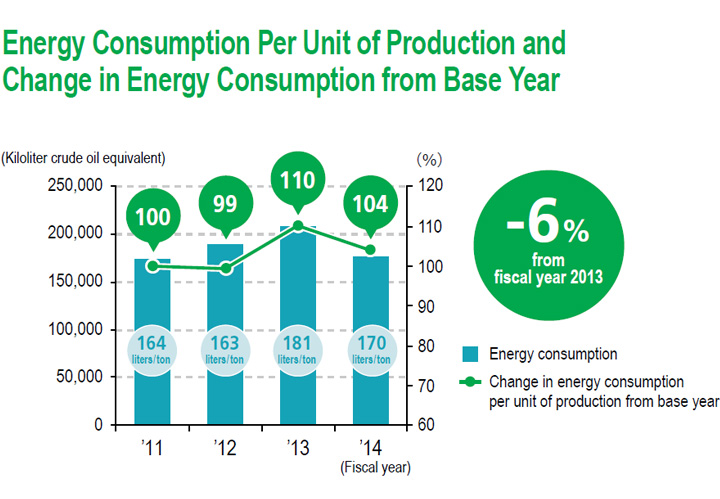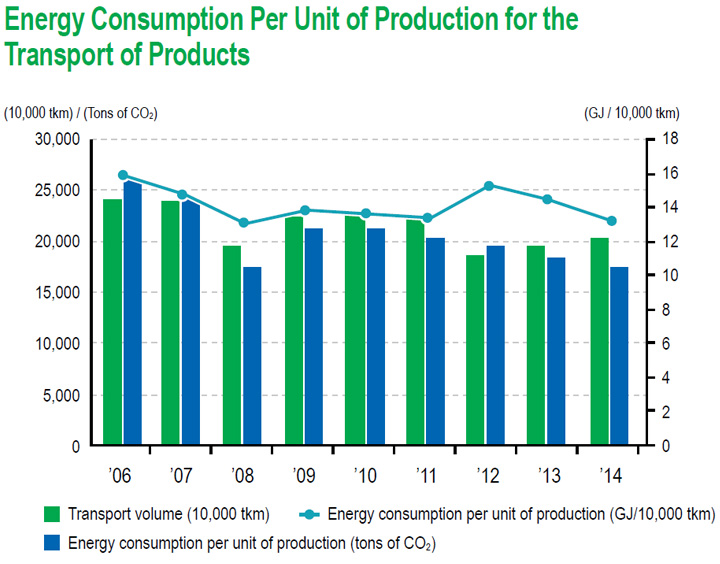Preventing Global Warming(2014)
Principal Initiatives in Fiscal Year 2014
-
Energy Consumption and CO₂ Emissions by the Global DIC Group
The DIC Group views energy consumption per ton of production as an important measure of its energy effciency. Against a 7.3% decrease in global production volume, the volume of energy consumed by the global DIC Group in fscal year 2014, calculated in kiloliters of crude oil, amounted to 288,452 kiloliters, down 10.5% from 322,210 kiloliters in the preceding fscal year, while energy consumption per unit of production declined 3.4%, to 148.4 liters/ton, from 153.7 liters/ton in fscal year 2013.
The Group also succeeded in reducing its global CO₂ emissions a remarkable 9.1% in fscal year 2014, to 657,457 tons, from 722,955 tons in fscal year 2013. This achievement was attributable to energy conversion and the installation of energy-effcient equipment at production facilities and other business sites worldwide, as well as to process improvements and the steady implementation of energy-saving initiatives. -
Energy Consumption and CO₂ Emissions by the DIC Group in Japan
In fscal year 2014, the DIC Group in Japan—which encompasses the 33 business sites of DIC and its domestic Group companies—reported a 3.6% decrease in production volume and a 1.4% decline in energy consumption. Nonetheless, energy consumption per unit of production rose 2.3%. The principal factor behind this result was a deterioration of energy effciency resulting from high-mix/low-volume production and an increase in base load resulting from the installation of a clean room to further enhance product quality. In contrast, CO₂ emissions were up 4.4%, owing to the inclusion from fscal year 2014 of emissions from non-energy sources (incinerators). If CO₂ emissions had been calculated on the same basis as in fscal year 2013, the Group would have reported a 0.3% decline.
Principal Reason for Increase in Energy Consumption Per Unit of Production
The increase in energy consumption per unit of production by the DIC Group in Japan in fscal year 2014 was primarily attributable to the start of operations by a new production facility for PPS neat polymer (an engineering plastic) at the Kashima Plant in Japan.
Factors Contributing to Increase in CO₂ Emissions by the DIC Group in Japan in Fiscal Year 2014
Factor Impact on CO₂
emissions (tons)Change in weight*
(percentage points)Notes Impact of energy-saving initiatives -6,883 -2.8 The implementation of 488 energy-saving initiatives accounted
for a 2,677 kl reduction in energy consumption.Changes in business portfolio -3,250 -1.3 Changes were due to, among others,
DIC taking over the business of an affiliate.Increase in operation of facilities powered
by renewable energy at the Kashima Plant-3,184 -1.3 Heat and power generated using renewable energy (biomass boilers,
wind power) increased 11% from fiscal year 2013, to 14,919 kl.Reduction of production volume -1,740 -0.7 Others 5,990 2.5 Start of full-scale operations at new PPS neat polymer
production facility at the Kashima Plant8,148 3.3 Energy consumption per unit of production at the new facility is high. Inclusion of CO₂ emissions from non-energy
sources from fiscal year 201411,566 4.7 CO₂ emissions from non-energy sources were included for the Chiba Plant only in fiscal year 2013.
In fiscal year 2014, such emissions were included for all domestic plants.Total 10,648 4.4 -
Energy-Saving Initiatives in Japan
he DIC Group promoted a number of highly successful energy-saving initiatives in Japan in fiscal year 2014. A total of 488 initiatives were implemented at domestic business sites, namely, plants and R&D sites. These included integrating production and replacing waste-heat boilers to reduce consumption of thermal energy, reconsidering refrigerants used in and the operating hours of air conditioning equipment to lower consumption of electric power, ensuring the efficient operation of air compressors and replacing existing lighting fxtures with LED lights to reduce the use of electricity. The Group also switched to clean energy, that is, to town gas from heavy oil, to fuel boilers at the Kashima Plant. These initiatives reduced energy consumption by 2,677 kiloliters (crude oil equivalent) (associated reduction in CO₂ emissions: 6,883 tons), equivalent to 13,385 200-liter drums of crude oil, or 2.8% of total energy consumption by the DIC Group in Japan in fscal year 2013.
Results of Energy-Saving Initiatives in Japan in Fiscal Year 2014
Number ofinitiatives Reduction in energy consumption (kl) Reduction in CO2emissions (tons of CO₂) DIC Corporation 406 2,175 5,859 Domestic DIC Group companies 82 502 1,024 Total 488 2,677 6,883 Expanding Application of System to Enhance the Visibility of Energy Consumption
With the aim of optimizing the use of electric power on an individual facility basis, DIC has developed a system that measures, monitors and verifes waste and irregularities in use, thereby enhancing the visibility of energy consumption. Initially installed at the Hokuriku Plant in 2012, the system—which won the ECCJ Chairman’s Prize at Japan’s 2012 Energy Conservation Grand Prize awards, sponsored by the Energy Conservation Center, Japan (ECCJ)—has since been rolled out at DIC business sites across Japan. In fscal year 2014, the system was installed at the Komaki Plant. To promote the further rationalization of energy use, a system for analyzing consumption during different production processes was installed on production foor B of the Sakai Plant. This is the third location to receive this system, which was also installed on production foor V of the Chiba Plant and production foor C of the Kashima Plant in fscal year 2013. DIC is also considering installation at the Yokkaichi Plant.
One outcome of efforts to enhance the visibility of energy consumption was an increase in the number of categories of Scope 3*, in which DIC reports indirect emissions of CO₂, from one (“upstream transportation and distribution”) in fscal year 2012 to six (including “capital goods” and “waste generated in operations”) in fscal year 2013.- Scope 3 is the Greenhouse Gas Protocol’s standard for calculating indirect greenhouse gas emissions resulting from production, transport, business travel and commuting, among others, across entire supply chains.
TOPICS1
Reducing energy consumption and increasing product quality through training to provideemployees with the tools to continuously improve their work
aving recognized that enhancing the awareness of employees in production and providing them with the tools to continuously improve their work are crucial to strengthening front-line capabilities, in 2008 DIC began offering the Kaizen Skill Improvement Training program. This program—which is structured around four themes, namely, reducing energy consumption, increasing yields, enhancing product quality and rationalizing operation—seeks to foster professionals who can identify and resolve issues on their own initiative. Participants spend one year participating in initiatives aimed at improving quality control methods and the following year putting their fndings into practice. Each December, achievements are presented at a briefng attended by pertinent plant general managers and directors.
Since 2012, DIC has also provided training for employees who have completed the Kaizen Skill Improvement Training program to equip them with the leadership and educational skills necessary to serve as instructors for the program. As of the end of fscal year 2014, a cumulative total of 332 employees from DIC sites in Japan had completed the Kaizen Skill Improvement Training program, with approximately 20% subsequently going on to earn accreditation as program instructors, adding momentum to energy-saving and other initiatives.I was reminded of the importance of being able to recognize issues.

I think that the data analysis presented at the briefng was easy to understand and persuasive. We provided explanations from a variety of unique perspectives and were successful in drawing the audience in. The whole experience of the program reminded me of the importance of being able to recognize issues. I look forward to capitalizing on what I learned to continuously improve my work.
Solid Compounds Production
Department, Komaki Plant
Kouichi NaitoTOPICS2
New energy-saving features of air conditioning equipmentaccount for reduction in energy consumption of approximately 20%
Two approaches introduced at production departments’ annual R&D presentation attract considerable attention
Revisions to Japan’s Act Concerning the Rational Use of Energy, aimed at leveling demand for electricity, have heightened the need to improve the energy effciency of air conditioning equipment, a major cause of rising energy consumption. Personnel at DIC’s Chiba Plant directed their attention to improving the performance of refrigerants, promoting two highly successful approaches that attracted considerable attention at the R&D presentation staged by the Company’s production departments every January.
① Replace R-22 with a green alternative
The frst approach involves replacing chlorofuorocarbon R-22, the most commonly used refrigerant for air conditioning equipment, with propane (similar to isobutane), a green refrigerant. Propane offers considerable benefts, including the fact that it does not deplete the ozone layer and has a lower global warming potential (GWP) than R-22, but its extreme fammability is a major disadvantage. For this reason, it has traditionally been viewed as unsuitable for chemical production facilities, although inverter technology has facilitated its use in environment-friendly household refrigerators. Having determined that propane is a viable alternative for certain production sites, in fscal year 2014 air conditioning equipment using propane instead of R-22 was installed on a trial basis at the Sakai Plant, a move that reduced annual energy consumption at the facility by 20–30%.
Japan is phasing out the production and use of R-22 and other high GWP chlorofuorocarbons and has set 2020 as its target date for completing this effort. Accordingly, the search is on for green refrigerants suitable for use in air conditioning equipment. With the completion of verifcation testing at the Sakai Plant, the Kashima Plant also installed air conditioning equipment using propane instead of R-22 in certain areas.② Increase operating effciency by eliminating air bubbles
The second approach adopted by personnel at the Chiba Plant was to improve the performance of existing refrigerants. Air conditioning equipment exploits a process called phase conversion—the transformation of a liquid to a gas and vice versa—that occurs as a result of the repeated compression and expansion of the refrigerant—to cool or heat air. However, the degradation of equipment over time can result in the formation of air bubbles during compression, thereby hampering the refrigerant’s performance. The Chiba Plant sought to address this issue by installing an air separator, which isolates and removes air, a move that signifcantly improved the air conditioning capacity of the equipment, helping to cut peak electricity demand and accounting for a 20% reduction in annual electric power consumption at the facility. DIC is confdent that the concurrent promotion of this and the approach described above at domestic production sites will play a key role in expediting production departments’ efforts to reduce energy consumption.
-
Increasing Independent Electric Power Generation through Cogeneration and the Use of Renewable Energy
Increasing Cogeneration System-Based Independent Electric Power Generation
With the aim of increasing energy efficiency, and as a precaution against natural disasters, the DIC Group in Japan is promoting the systematic adoption of cogeneration and the use of renewable energy, that is, energy from sources that are naturally replenished. Cogeneration systems burn fuel to drive turbines, facilitating the production of electric power and the recovery and reuse of waste heat (steam and hot water), thereby improving energy effciency.
The DIC Group currently has cogeneration systems at fve domestic plants (Chiba, Shiga, Saitama, Gunma and Tokyo) with a combined maximum capacity of 19,000 kW. In fscal year 2014, electric power produced by these systems accounted for 14% of the total volume of electric power used by the DIC Group in Japan. In autumn 2015, DIC will install a gas turbine-powered cogeneration system at its Kashima Plant with a capacity of 1,700 kWh. DIC is also considering updating the cogeneration system at its Chiba Plant, which currently has a capacity of 6,000 kW.Using Renewable Energy
In Japan, the DIC Group actively promotes the use of energy from renewable sources (biomass, wind power and solar power) at suitable sites. In fiscal year 2014, DIC dramatically enhanced the generating capacity of biomass boilers (4,000 kW and 30 tons of steam per hour) by improving the quality of the wood chips used to fre boilers and reinforcing maintenance procedures, which facilitated a significant increase in operating rates, boosting output of both electric power and steam (waste heat). The Group also raised operating rates at its two wind power generation facilities (each has a generating capacity of 2,300 kW). These improvements, together with contributions from a small solar power plant, resulted in an increase in the DIC Group’s renewable energy output in Japan of 7.9% from fscal year 2013, while independently generated renewable energy accounted for 8% of all electric power consumed by the domestic Group. As a consequence, the Group’s CO₂ emissions in calendar year 2014 were down 39,735 tons, or 11%, from calendar year 2013.
Leveraging the biomass boiler management technologies it has developed through operation of facilities at its Kashima Plant, in 2016 DIC plans to expand the installation of such boilers to include its Hokuriku Plant, in Ishikawa Prefecture.Electric Power Produced through Cogeneration and the Use of Renewable Energy
DIC Group (Japan) Electric power consumed (a) Electric power produced through cogeneration (b) (b) as a % of (a) Electric power produced through theuse of renewable energy (c) (c) as a % of (a) Fiscal year 2013 292,637,000 kWh 44,268,000 kWh -15.1% 20,938,000 kWh 7.2% Fiscal year 2014 281,257,000 kWh 39,472,000 kWh -14.0% 22,602,000 kWh 8.0% Change -11,380,000 kWh -4,796,000 kWh -1.1% 1,664,000 kWh + 0.8% Change (%) -3.9% -10.8% + 7.9% TOPICS3
Microreactor: Realizing production processes that lower environmental impact
To date, the majority of synthetic chemicals have been produced in batch reactors, where two or more different chemical elements are combined, causing a chemical reaction, and byproducts and impurities are removed. Because heat exchange effciency is low, heating and cooling require signifcant amounts of energy. Also, precise thermal control is diffcult, as a result of which it is diffcult to manage reaction effciency and quality.
R&D aimed at addressing these challenges opened the way for microreactors, which employ a number of unique processes. With microreactors, the introduction of raw materials and the reaction and recovery of byproducts and impurities occurs in a continuous fow within micro fuid channels that deliver superb heat exchange effciency. In addition to a signifcant reduction in energy use, microreactors facilitate precise thermal control—thereby minimizing electric power consumption and greatly improving reaction effciency and quality—and the reduction of waste. Microreactors also allow reactions and chemical synthesis processes that are unfeasible with batch tank reactors due to safety concerns, the benefts of which include shorter lead times for plant construction.
Having recognized the potential of microreactors early on, DIC has promoted extensive R&D aimed at developing a commercially viable unit. In September 2013, the Company’s Hokuriku Plant deployed a microreactor for use in the production process for fuorinated surfactants, achieving a signifcant improvement in reaction effciency that reduced production time to 1/9 the previous level, thereby reducing energy consumption and essentially eliminating the generation of waste during production.
As an organization engaged in the development and production of a diverse range of chemical compounds, DIC recognizes the importance of revolutionizing production processes as a way to enhance the quality of its products and lower its impact on the environment. As such, and with the aim of ensuring its own sustainability, the Company will continue working actively to develop production processes that reduce the environmental impact of its operations. -
Energy Consumption and CO₂ Emissions by the DIC Group Overseas
In fscal year 2014, energy consumption by DIC Group companies overseas amounted to 176,600 kiloliters, calculated in kiloliters of crude oil, a decrease of 15.4%, while CO₂ emissions per unit of production were 402,343 metric tons, down 15.9%. Since changes in reporting boundaries accounted for a decline of approximately 5% in each category, the principal factor behind these signifcant reductions was an increase in the energy effciency of production activities—underscored by an improvement in energy consumption per unit of production, a decrease of 5.7%—attributable to Groupwide efforts to step up energy-saving initiatives and effciency-oriented facility updates.
-
Energy-Saving Initiatives Overseas
Laws and regulations, as well as infrastructure, differ between countries and regions. The DIC Group strives to promote energy savings and efficient operations wherever it is active and in so doing to set precedents for the global chemicals industry. Against a 10.3% decline in production volume, energy-saving initiatives by DIC Group companies overseas in fscal year 2014 reduced energy consumption 15.4% and yielded a 5.7% improvement in energy consumption per unit of production. These achievements supported a substantial decline in associated CO₂ emissions of 15.9%, or 76,235 tons.
Results of Energy-SavingInitiatives Overseas in Fiscal Year 2014
Number ofinitiatives Reduction in energy consumption (kl) Reduction in CO₂ emissions (Tons of CO₂ ) Greater China 26 374 842 Asia–Pacifiregion 61 885 1,960 Total 87 1,259 2,802 Greater China
In November 2014, 26 energy offcers from 16 sites in the PRC gathered at DIC Zhangjiagang Chemicals Co., Ltd., a manufacturer of synthetic resins in Zhangjiagang, Jiangsu Province, in the PRC, for an energy management conference on the theme of energy-saving and wastewater processing. Participants reviewed initiatives, and shared information on ongoing challenges and discussed future plans. A representative of DIC’s Production Control Department gave a presentation using the Company’s installation of LED lights and efforts to promote the effcient operation of air compressors as case studies.
Authorities in the PRC are encouraging companies to switch from light oil to environment-friendly town gas, as well as to make use of an active biodiesel refined from vegetable matter. DIC Group companies in the PRC are exploring the possibility of making this switch, examining such considerations as infrastructure and site locations. Shanghai DIC Ink Co., Ltd., which manufactures printing inks, began using biodiesel in fscal year 2013. The company plans to replace 90% of its boiler fuel with biodiesel in fscal year 2014.Other Initiatives
Zhongshan DIC Colour Co., Ltd.
DIC Synthetic Resins (Zhongshan) Co., Ltd.
Shenzhen-DIC Co., Ltd.
Switched boiler fuel from light oil to natural gas
Nantong DIC Color Co., Ltd.
Transformed heat sources for showers (electric heaters) into waste heat recovery units for exhaust gas boilers
DIC Zhangjiagang Chemicals Co., Ltd.
Increased operating effciency of circulating pumps in chillers
Asia–Pacifiregion
In September 2013, 25 energy offcers from 19 sites in 11 countries and territories in the Asia–Pacifc region gathered for a conference on energy management issues and measures. Participants discussed increases in energy consumption in emerging economies due to economic expansion, as well as the horizontal deployment of measures that have proven effective in addressing issues specifc to the region.
In fscal year 2014, production volume in the Asia–Pacifc region increased, owing to the acquisition of a manufacturer in the preceding period. Nonetheless, the active promotion of energy-saving initiatives at individual sites resulted in a decline in associated CO₂ emissions per unit of production of 1,960 metric tons. In fscal year 2015, the DIC Group will implement strategic measures aimed at principal energy-consuming sites to reduce dependence on high-emission energy sources, including the installation of facilities for the independent generation of renewable energy, and will work to establish quantitative targets for the region as a whole.Principal Initiatives
Siam Chemical Industry Co., Ltd. (Thailand)
① Switched from existing coolant pumps to high-effciency models;
② Updated light fxtures (installed LED lights)PT DIC ASTRA Chemicals (Indonesia)
① Installed electricity monitoring system across entire site;
② Updated light fxtures (installed LED lights)DIC Epoxy (Malaysia) Sdn. Bhd.
Added inverter controls to all fve coolant pumps
DIC Graphics (Thailand) Co., Ltd.
① Added inverter controls to coolant pumps;
② Updated light fxtures (installed LED lights)DIC Compounds (Malaysia) Sdn. Bhd.
Updated light fxtures (installed LED lights)
DIC Fine Chemicals Private Limited (India)
Updated light fxtures (installed LED lights) across entire site
Americas and Europe
In October 2013, the Sun Chemical Group—which has operations in 13 countries in North, Central and South America and 43 countries in Europe—rolled out a new internal Web-based data collecting system called EcoTrack, which facilitates the collection and centralized monitoring of data for key sustainability metrics related to energy, water, waste and safety at 153 sites. In addition to increasing the transparency of site data related to production, energy-saving initiatives and CO₂ emissions, among others, EcoTrack was designed to encourage the sharing of information and the horizontal deployment of measures. The full implementation of the system across the Sun Chemical Group in fscal year 2014 greatly increased the transparency of crucial data, which in turn accelerated the cycle of analyzing data, formulating responses and deploying measures, signifcantly increasing the progress of energy-saving initiatives. At two sites, for example, the mounting of sensors on production equipment and analysis of resulting data facilitated the calculation of optimum electric power and operating times for individual processes to minimize wasted power and optimize production. As a consequence, both sites succeeded in boosting production volume while substantially lowering their use of electric power, enabling both to achieve noteworthy reductions in both energy consumption and costs.
VOICE
We continue to explore new ways to increase motivation.

Until now, the principle indicator of energy effciency has been energy consumption per unit of production, which measures volume of energy used against production output. However, in the chemicals industry the trend is toward high-value-added products and high-mix, low-volume production, so you can’t look only at consumption per unit of production. For this reason, we will increase the weighting of energy-saving initiatives that lead directly to cost reductions in our next three-year management plan and promote the creation of new schemes aimed at increasing employee motivation.
General Manager, Production Control Departmentbr
Michio Uchiyama -
Reduction of Greenhouse Gas Emissions Attributable to Logistics
In fiscal year 2014, DIC examined its upstream distribution bases to identify those with low efficiency levels and implemented measures aimed at improving transport options for relatively short distances. Thanks to these and other efforts, energy consumption in logistics and associated CO₂ emissions declined 2.0% and 5.0%, respectively, despite an increase in transport volume. The principal factor behind these improvements was the promotion of modal shift focusing on marine, rail and air transport, underscored by a 23.2% increase in the volume of products shipped using these modes of transport. The volume of products transported by container ship rose 7.1%, while transport by rail climbed 40.0%. The DIC Group’s modal shift rate in fscal year 2014 was 10.7%, up from 9.1% in the preceding period.
-
Initiatives in Areas Other than Production
In fscal year 2014, DIC once again promoted efforts in line with Japan’s Cool Biz and Warm Biz campaigns, offcial efforts to reduce electric power consumption by limiting the use of air conditioning in summer and winter through measures such as the introduction of more relaxed offce dress codes. The Company also continued to promote efforts aimed at reinforcing employees’ awareness of the importance of lowering energy consumption, including replacing superannuated light fxtures and air conditioning equipment in offces and sites with newer, high-effciency models that satisfy standards set by the ECCJ for its Top Runner program, turning off lights when not needed and implementing mandatory 22° winter and 28° summer air conditioning settings.
-
Reporting to the CDP
The CDP (formerly the Carbon Disclosure Project) is a global nonproft organization (NPO) that works on behalf of institutional investors to motivate companies to disclose information on initiatives to combat climate change and key environmental data. The CDP analyzes and evaluates information reported by companies and communicates its fndings to said institutional investors. DIC has been reporting to the CDP since 2010. The CDP has recognized the Company’s consistent environmental initiatives and in fscal year 2014 awarded it an overall score of 89B (89 points for disclosure and a performance class of B), signifcantly exceeding the average for companies based in Japan, which is 78B.
VOICE
We are taking steps to prepare for the liberalization of Japan's energy sector.

In March 2015, the Cabinet of Japan approved bills to separate transmission and distribution from the country’s electric power frms, which currently have regional monopolies, in 2020 and to liberalize the town gas retail market in 2017. These changes will broaden the energy supply alternatives available to both commercial users and consumers. To date, we have reviewed contracts with electric power suppliers at a number of domestic DIC Group sites and have achieved substantial cost reductions by procuring from suppliers offering packages combining both. With Japan’s energy industry at a major turning point, it is crucial that DIC Group sites promote further efforts tailored to regional supply infrastructures—including installing independent generating facilities—to ensure continued operating effciency.
Manager in charge of effciency, Production Administrative Division
Kazuo Kawaguchi
Back number
- Principal Initiatives in Fiscal Year 2021
- Principal Initiatives in Fiscal Year 2020
- Principal Initiatives in Fiscal Year 2019
- Principal Initiatives in Fiscal Year 2018
- Principal Initiatives in Fiscal Year 2017
- Principal Initiatives in Fiscal Year 2016
- Principal Initiatives in Fiscal Year 2015
- Principal Initiatives in Fiscal Year 2014
- Principal Initiatives in Fiscal Year 2013

